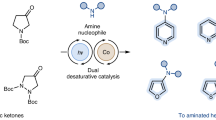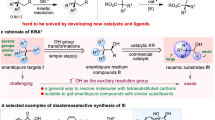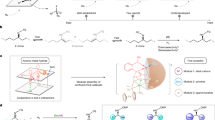Abstract
DURING some polarographical investigations of certain α-aminoketones1 and on the elimination of Mannich bases2 experimental data were gathered, which can be explained by the occurrence of keto-enol transformation. Though considerable attention has been paid to the mechanism of polarographical reduction of carbonyl compounds3, no experimental evidence has been adduced for the participation of the keto-enol tautomerism in the reduction of the carbon–oxygen bond. This follows from the fact that, in most cases examined, the keto form is the predominating form, and in buffered solutions used, establishment of keto-enol tautomeric equilibrium is fast. However, the decrease of the limiting current of some keto acids has recently been interpreted4 as being influenced by the keto-enol equilibrium in addition to hydration. Experimental evidence for the role of enolization in the behaviour of substances like acetyl and acetonyl acetone5 is unconvincing. On the other hand, it has been discovered that the enolate form participates when anodic waves occur, corresponding to the formation of mercury salts, in alkaline solutions of enolizable ketones (Heyrovský, M., private communication). Keto-enol equilibria were involved also in the complicated and, in some ways, questionable scheme derived6 for the reduction of thenoyl trifluoroacetone.
This is a preview of subscription content, access via your institution
Access options
Subscribe to this journal
Receive 51 print issues and online access
$199.00 per year
only $3.90 per issue
Buy this article
- Purchase on SpringerLink
- Instant access to full article PDF
Prices may be subject to local taxes which are calculated during checkout
Similar content being viewed by others
References
Zuman, P., and Horák, V., Collect. Czechoslov. Chem. Comm., 26, 176 (1961).
Michl, J., Thesis, Charles University, Prague (1961).
Calzolari, C., Furlani, C., Ann. Chim. (Roma), 44, 356 (1954). Holleck, L., and Marsen, H., Z. Elektrochem., 57, 301 (1953). Kastening, B., and Holleck, L., ibid., 63, 166 (1959). Elving, P. J., and Leone, J. T., J. Amer. Chem. Soc., 80, 1021 (1958). Nagata, Y., Rev. Polarography, 7, 12 (1957). Mandell, L., Powers, R. M., and Day, jun., R. A., J. Amer. Chem. Soc., 80, 5284 (1958).
Ono, S., Takagi, M., and Wasa, T., Collect. Czechoslov. Chem. Comm., 26, 141 (1961).
Semerano, G., and Chisini, A., Gazz. Chim. Ital., 66, 504 (1936). Brdička, R., Chem. Listy, 39, 35 (1945). Vitjajeva, S. I., and Markman, A. L., Dokl. Akad. Nauk Uzbek, S.S.R., No. 8, 33 (1957).
Elving, P. J., and Grodzka, P. G., Anal. Chem., 33, 2 (1961).
Lund, H., Acta Chem. Scand., 14, 1927 (1960).
Author information
Authors and Affiliations
Rights and permissions
About this article
Cite this article
ZUMAN, P., MICHL, J. Role of Keto-Enol Tautomerism in the Polarographical Reduction of Some Carbonyl Compounds. Nature 192, 655–657 (1961). https://doi.org/10.1038/192655a0
Issue date:
DOI: https://doi.org/10.1038/192655a0
This article is cited by
-
Electrochemical investigations on β-chlorovinylaldehydes in aprotic media
Proceedings / Indian Academy of Sciences (1989)



